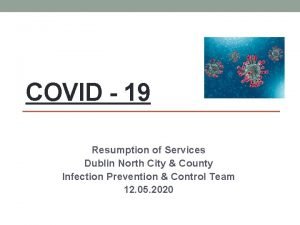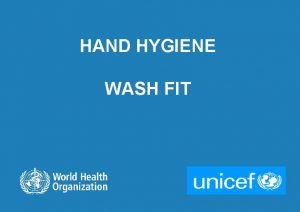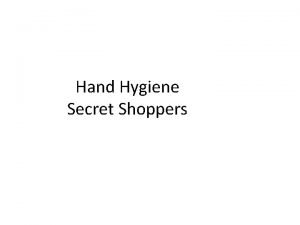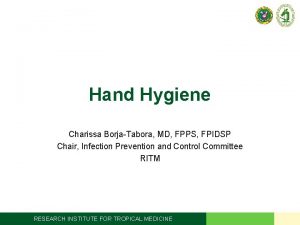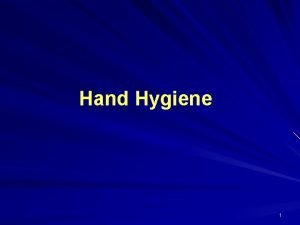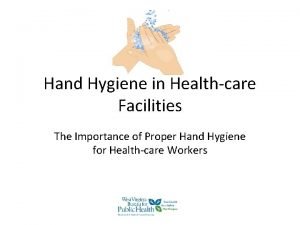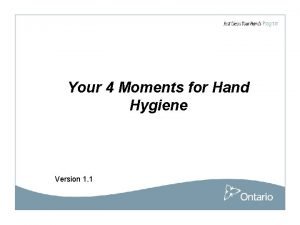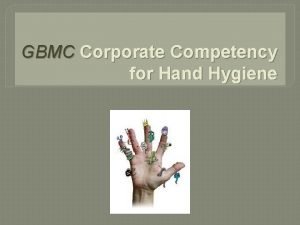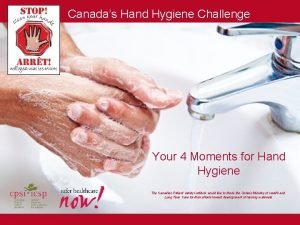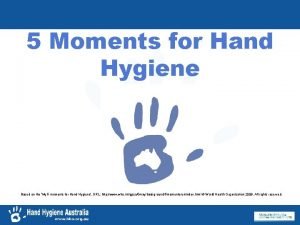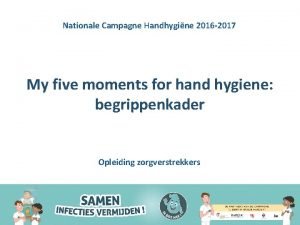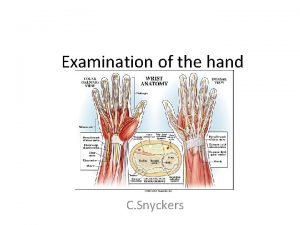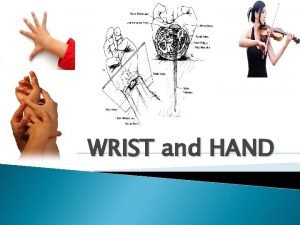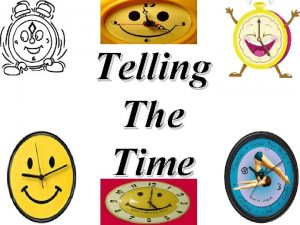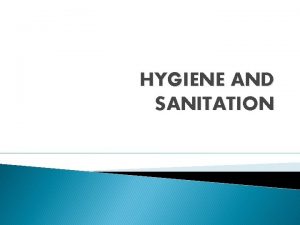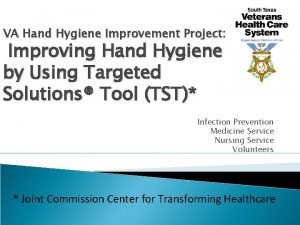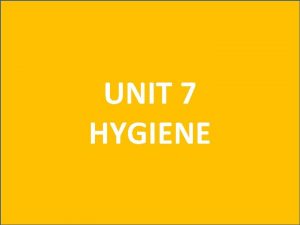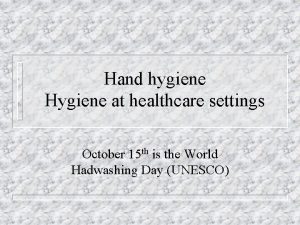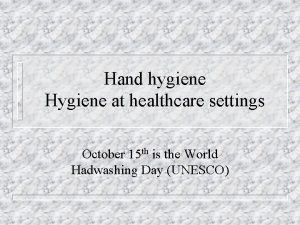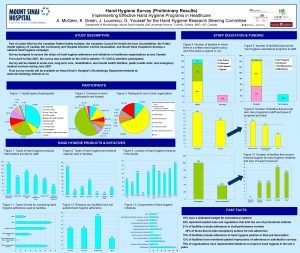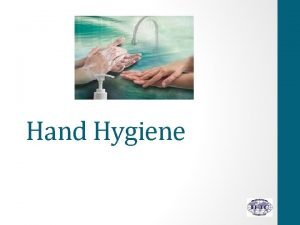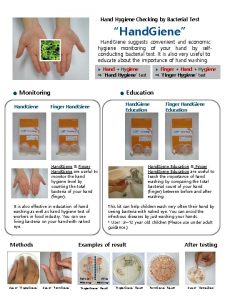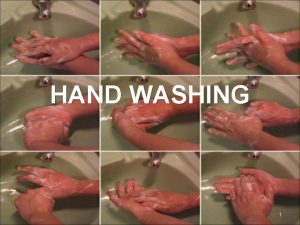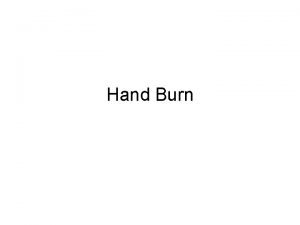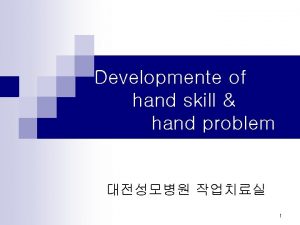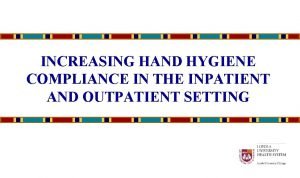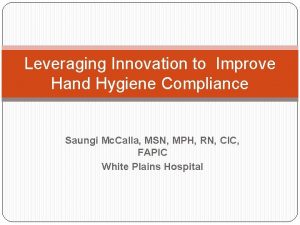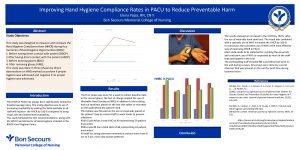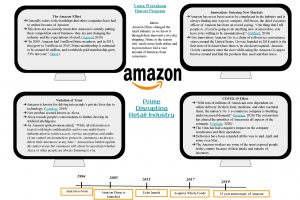Measurement of Hand Hygiene Compliance Dr Sanjeewani Weerakoon


































- Slides: 34

Measurement of Hand Hygiene Compliance Dr. Sanjeewani Weerakoon MBBS, Dip. Micro, MD Microbiology SBSCH, Peradeniya

Measuring Hand Hygiene Compliance �Why do you measure? �what are your organization’s goals? � What elements of hand hygiene to measure? � How to measure?

Measuring Hand Hygiene Compliance 1. Directly observing 2. Measuring product use 3. Conducting surveys

Direct Observation �Directly watching and recording the hand hygiene behavior of health care workers and the physical environment

Direct Observation �How to perform? � Select a unit �Decide time period �Select target group- Dr/NO/Physiotherapist/ Minor staff/others…. �Conducted by trained observers �Decide what to observe-opportunities/ actions, product use/ thoroughness of HH/ gloves use

Direct Observation �How to perform ? . . . cont �Conduct recording with validated Auditing tool �Observe 20 min from open space/ minimum 200 opportunities �Observer should not interfere the routine work of the unit �Confidential �Measure compliance according to the HH guidelines


Direct Observation � “Gold Standard” � Reliable if performed well � Can pin point problem areas, staff, times and improvement opportunities � Able to detect all opportunities for hand hygiene � Must define “opportunity for hand hygiene”

Strengths of Direct Observation Can precisely designate areas for improvement and target efforts and resources � Person (s)/ Time of Day/ Shift/ Unit Can evaluate thoroughness of cleansing /technique � Application/ Time of process/ opportunities Glove use/ Jewelry, Nails

Strengths of Direct Observation � Observers could give prompt feedback when improvement is needed. �Evaluate facility-specific factors that may influence hand hygiene guideline adherence � Allows for a denominator, rate and comparison over time Adherence rate = Total number of acts of hand hygiene when the opportunity existed ----------------------------------------Total number of hand hygiene opportunities

Direct Observation - Challenges �Labor intensive Requires a presence Requires observer time – many hours � Trained and validated observers � Costly – many hours to obtain �sufficient observations for analysis

Direct Observation – Challenges Bias � Observer � Selection Bias � Sample Size � Timing � Variation in Staff Behaviors( Hawthorne effect)

Standardizing Observation �The Importance of Observer Training and Assessing Reliability. �Interrater reliability or interobserver reliability (Reliability among observers). �User-friendly forms with clear instructions.

Other Direct Observation Methods � Video Cameras �Patients as Observers of Staff Hand Hygiene

Patients as Observers of Staff Hand Hygiene

MEASURING PRODUCT USE �measure Product utility by health care workers in a unit or organization �Indirect Measurement of Hand Hygiene

Measuring Product Use two primary ways to measure product use. 1. measure the amount of a product that is used 2. measure the frequency with which the product is used

Measuring the Amount of Product Used �Weigh or measure the height of soap or alcohol-based hand rub remaining in the dispenser �Measure the height of a stack of paper towels from one period of time to another. �Count the number of soap or alcohol-based hand rub containers, the stacks of paper towels placed on a unit �Number of empty containers removed from the unit. �Calculate the amount of product used at the specific unit, department

Measuring the Amount of Product Used �by looking at purchasing or inventory data of entire health care organization. �Data on the quantity of products ordered or supplied throughout the organization at regular intervals (e. g. monthly, quarterly, annually)

Measuring the Frequency of Product Use automated tools— �Electronic counting devices � attached in Alcohol hand rub dispensers � Electronic monitoring devices �Electronic Monitoring of Sink Use �Emit sounds as reminders to perform HH. �Able to track and record individual HCW. �New and expensive

Strengths of Measuring Product Use �Less resource intensive, less expensive �More efficient than the observation method �Can be done either manually or electronically. �Allows organization wide trends to be tracked over time. �Unobtrusive �Reduces Hawthorne effect �Reduces sampling bias

Strengths of Measuring Product Use �Product use can be measured across all shifts, 24 hours a day, 7 days a week. �Minimal staff training. �Can be done in many different health care settings.

Limitations of Measuring Product Use � The validity has not been well established. �Does not reveal whether health care workers perform hand hygiene when indicated. � Product use does not provide any information about �when and why hand hygiene does not occur. � technique

Limitations of Measuring Product Use �inaccurate and misleading results can be produced �Waste/spillage �Product use by patients and family members �Exchange product between units �No. of opportunities vary with units, pt population…. .

CONDUCTING SURVEYS �Surveys gather information on health care worker perceptions, attitudes, and practices related to hand hygiene, as well as patients’ and families’ attitudes and perceptions of the hand hygiene practices of health care workers � Indirect method

CONDUCTING SURVEYS Surveys can be done: �Over the telephone �Electronically (over a computer network or via the Internet), �On paper (on-site or via mail) � Through interviews (personal or focus groups)

CONDUCTING SURVEYS Surveying health care workers can assess: � Staff knowledge �Staff attitudes and beliefs �Staff perceptions of their own, or their colleagues on HH behavior �Structural factors that can facilitate or inhibit staff for HH �Staff satisfaction with products �Assessment of staff skin condition �Structural issues, availability of products, product accessibility

CONDUCTING SURVEYS �Surveying patients and families can assess: attitudes and perceptions of hand hygiene practices of health care workers. �HCWs perception of HH is match with the perception of patient and family……?

Surveying patients…….

Strengths of Using Surveys �Reasons for non- adherence to HH guidelines �Inexpensive �Not resource intensive

Limitations of Using Surveys �Inadequate validity or reliability for self-respect of adherence �HCW tend to overestimate compliance �Validity depends on the quality of the survey’s development and testing � Recall bias

Measuring Hand Hygiene Compliance Using more than one method >> > using a single method. �Yield reliable results � Help to validate the results � Uncover additional information �Areas need improvement �Target interventions


THANK YOU!
 Workplace hygiene procedures
Workplace hygiene procedures Dr sanjeewani fonseka
Dr sanjeewani fonseka Dr.sanjeewani fonseka
Dr.sanjeewani fonseka Dr. sanjeewani fonseka
Dr. sanjeewani fonseka Sanjeewani fonseka
Sanjeewani fonseka Dr sanjeewani fonseka
Dr sanjeewani fonseka Dr sanjeewani fonseka channeling
Dr sanjeewani fonseka channeling Four moments of hand hygiene
Four moments of hand hygiene Nasceducation
Nasceducation Objectives of hand hygiene
Objectives of hand hygiene Hand hygiene
Hand hygiene 5 moments of hand hygiene quiz
5 moments of hand hygiene quiz Hand hygiene competency
Hand hygiene competency Hexachloraphene
Hexachloraphene Gmp training dvd
Gmp training dvd Hand hygiene self assessment framework
Hand hygiene self assessment framework Four moments of hand hygiene
Four moments of hand hygiene Gbmc infoweb
Gbmc infoweb 4 moments of hand hygiene canada
4 moments of hand hygiene canada Hand hygiene moment 3
Hand hygiene moment 3 Targeted solutions tool
Targeted solutions tool Who hand hygiene moments
Who hand hygiene moments Alabama driver manual
Alabama driver manual Mother father sister brother
Mother father sister brother Tools equipment and processes
Tools equipment and processes Which is hour hand
Which is hour hand Benediction sign
Benediction sign Operation process chart example
Operation process chart example Put your left hand in
Put your left hand in Right hand in the air left hand in the air
Right hand in the air left hand in the air Hand of benediction
Hand of benediction Hand by hand
Hand by hand Gedicht im abendrot
Gedicht im abendrot Ape hand vs hand of benediction
Ape hand vs hand of benediction Hour hand and minute hand
Hour hand and minute hand








